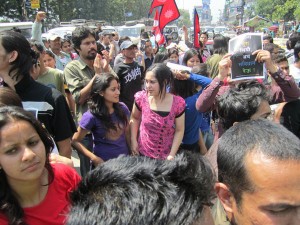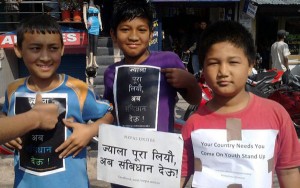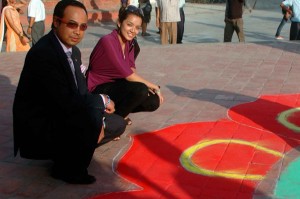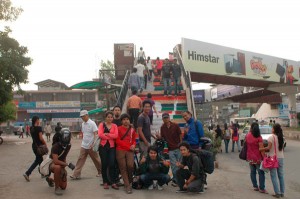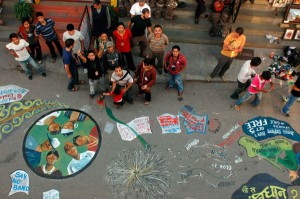‘So, what exactly do you do here?’
Six months after Sattya Media Arts Collective established itself in its current building behind the zoo in Jawalakhel, this is one of the questions we hear most. And that’s fair enough, because for most people, a media arts collective is a new concept.
It was new for me, too, when I came to Kathmandu almost five months ago to intern with Sattya.
Sattya aims to be resource network for creative people in Nepal ‘for writers, photographers, filmmakers, journalists, artists, and storytellers of any medium. Sattya is a place where people can come and not only learn new skills, but share their skills as well; where people can express their own opinions in addition to hearing about the perspectives of others.
Sattya began when photographer and filmmaker Anya Vaverko and VENT! Magazine founder Yuko Maskay started talking about setting up a creative space in Kathmandu. Anya and Yuko saw that there were so many enthusiastic creative people here who lacked a place where they could gather and inspire each other. At almost every event or workshop, there is somebody who says to us ‘Wow, I didn’t know that this sort of place existed in Kathmandu’.
At Sattya, we want to make media accessible to everyone, whether they come from an artistic background or not. Our workshops and screenings have been attended by engineering students, bankers, salespeople, forestry workers, and communications consultants, in addition to writers, photographers, artists, musicians, and filmmakers. Our vision is to eventually be able to reach out to rural and non-English-speaking people as well as our current urban audience. We’re not there quite yet, but we’re working on it.
Some of Sattya’s most popular events are our weekly documentary film screenings, shown either on our rooftop or in the screening room, depending on the weather and season. We’ve shown documentaries on philosophy, DIY culture, religion, women’s rights, and climate change, shot in locations as varied as Liberia, Mongolia, Palestine, the US, and the Pacific.
In addition to our regular screenings, Sattya also runs a program called Docutalk, in which everyone is invited to take part in a post-film discussion with speakers knowledgeable about the film’s issues. In September, our Docutalk screening explored globalisation and garbage management through the Cairo-shot documentary Garbage Dreams, and featured speakers from trash and recycling organisations like WEPCO and the Kevin Rohan Memorial Fund. Docutalk is a great way to develop a different perspective on issues relevant to us ‘when we watch a story unfold on the screen, it touches us and provides us with a deeper understanding. Because of that, the post-film dialogue that is so central to Docutalk is not formal or theoretical. Everyone can have their say.
Sattya also offers media skills sharing workshops. Some of our members’ favourite workshops so far have focused on topics including blogging, photography, audio storytelling, and stencil making.
One area that we haven’t so far provided much training in, however, is that of filmmaking. This is because filmmaking requires a serious time commitment from both participants and facilitators. But there is some good news on the horizon ‘Sattya is planning a whole host of longer, more intensive workshops on film and photography that will take place over the next few months and into 2012.
Although we do love films in general, Sattya’s trainings and screenings focus on documentaries. We do this because we believe that documentaries provide different perspectives to those given by fiction films. Documentaries allow people to speak for themselves, and to tell their own stories about their lives, their experiences, and the issues that affect them and their communities.
Our favourite documentaries have a few things in common: they have little or no narration; they follow an individual or a family closely and without hiding anything; they show us lives and lifestyles we would not otherwise be able to come close to understanding; they leave us with more questions than answers; and they are filmed over long periods of time ‘three years in the case of one of our most-loved documentaries, Last Train Home.
But most of all, our favourite documentaries are simply inspiring. They are beautifully shot, they make us ask questions, and they leave us wide-eyed at the end, wanting to know more. They do not just advocate for a cause, nor just show pretty pictures or scenes of poverty. They invite us in, keep us riveted, and tell us a story. Sometimes we even forget they are documentaries.
This is why we believe documentary filmmaking to be a hugely important skill to share with others.
‘Documentaries allow us to understand a perspective that is totally different from our own and to look into a lifestyle, a world, that is maybe totally foreign to us,’ Anya says. ‘Unlike other media, such as photography or writing, documentaries appeal to people no matter what their literacy, education or background is.’
‘Documentaries have a tendency to touch us more than a news article and often more than a photo, even though those are also important media. A documentary can push people into action, can cause people to change their perspectives, and can also be just an amazing tool to teach people about the world around them.’
Although a number of documentaries have been made in Nepal, and despite the hard work of some great organisations and film festivals, few local documentaries have managed to reach a broad audience. Many international documentaries are also poorly-distributed or simply go un-shown in Nepal, as well as in many other places around the world. Sometimes, the only documentaries people have seen are those that were shown to them in school, which often leads people to think of all documentaries as boring.
‘Documentaries don’t have to just be about poverty or sad stories. They can be funny, they can be inspiring, they can be about anything. They can be shot beautifully, and they can be just as interesting as a fiction film, if not more. ‘Fact is stranger than fiction’, right?’
That said, documentaries can still be powerful tools for advocacy and activism. ‘At their best, they can change people’s perspectives and bring about real social change,’ Anya says. ‘Nepal must have millions upon millions of untold stories. They deserve to be recognised and shared.’
For aspiring documentary filmmakers, Anya’s advice is to push the boundaries and break the mould.
‘Documentaries that take place in Nepal don’t have to start with a montage of the Himalayas, Durbar Square, and city traffic, overlaid with traditional Nepali music. I want to see documentaries that are not made for foreigners about ‘the mystical Himalayan kingdom’ or a poverty-stricken third-world country.’
‘I want to see more documentaries made for a Nepali audience, both urban and rural, on themes like the urban arts and music scene, or what it’s like growing up a transgender child in a rural village, or what it’s like being a woman who is forced to live in a shed during her period.’
Even the smallest two sentence article in the newspaper is just waiting to be turned into a powerful, meaningful documentary.

